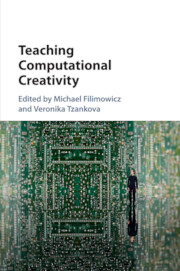Book contents
- Teaching Computational Creativity
- Teaching Computational Creativity
- Copyright page
- Contents
- Figures
- Tables
- Notes on Contributors
- Acknowledgments
- Introduction: Pedagogies at the Intersection of Disciplines
- PART I NEW FOUNDATIONS
- PART II CODE AS MEDIUM
- PART III PHYSICAL{LY} COMPUTING
- PART IV ONLINE LEARNING
- PART V CRITICAL PEDAGOGY
- PART VI TRANSDISCIPLINARY
- Interviews
- Afterword: Toward a Curricular Synthesis
- Index
- References
PART III - PHYSICAL{LY} COMPUTING
Published online by Cambridge University Press: 04 July 2017
- Teaching Computational Creativity
- Teaching Computational Creativity
- Copyright page
- Contents
- Figures
- Tables
- Notes on Contributors
- Acknowledgments
- Introduction: Pedagogies at the Intersection of Disciplines
- PART I NEW FOUNDATIONS
- PART II CODE AS MEDIUM
- PART III PHYSICAL{LY} COMPUTING
- PART IV ONLINE LEARNING
- PART V CRITICAL PEDAGOGY
- PART VI TRANSDISCIPLINARY
- Interviews
- Afterword: Toward a Curricular Synthesis
- Index
- References
Summary
In this chapter, we present the teaching initiative of Interaction Design and Physical Computing that is currently under development at Pontifícia Universidade Católica do Rio de Janeiro – PUC-Rio in Brazil, within the class called Interfaces Físicas e Lógicas, and in the LIFE Lab – Laboratório de Interfaces Físicas Experimentais. A discussion about the emerging area of Physical Computing in the field of Interaction Design is conducted from the conceptual framework of its practice and teaching initiatives in the Design school used for the study. In this context, thoughts on Design Thinking and Reflective Practice by theorists such as Donald Schön, Herbert Simon, and Nigel Cross are brought into the scene, as part of a learning methodology proposal, exploring the relation between the theory of Design and its practice. To expand the discussion, Weiser's ubiquitous computing concept is added as one more approach. In this sense, the idea that we live surrounded by digital interfaces embedded in objects that assist us in activities related to communication, information, entertainment, safety, health, and wellbeing becomes each day more present. Thus we are witnessing the rise of a new area of Design practice, in which designers, besides being users of the digital interactive systems, are involved in the process of development of the interfaces that are responsible for the mediation between the computer systems and men. This emerging area of Design is called Interaction Design, an area that has the discipline known as Physical Computing – in Brazil, Interfaces Físicas – as a key content. The discipline explores the relationship between the physical world and computer systems. Another author, who is brought to the discussion, is O'Sullivan, who advocates that through the use of software, hardware, electronics, sensors, microcontrollers, automation systems, and motors, the Physical Computing devices are digital interactive systems that sense and react to the physical world. Even though there is undeniable growth of the Interaction Design field globally, in Brazilian Design Courses there are still few academic initiatives concerning its teaching, especially at the undergraduate level. In this context, the Interfaces Físicas e Lógicas class from PUC-Rio's Design-Digital Media course has been – since 2010 – among the first Physical Computing classes offered in a Brazilian undergraduate Design program. This teaching–learning initiative has come together with the conception of a laboratory, designed as a space for the practice of Physical Computing. The LIFE Lab is an initiative of PUC-Rio's Department of Arts & Design that aims to provide students with the appropriate environment and technology for the practical development of Physical Computing projects. The lab is integrated to the other labs of the design program such as the product design lab, and the graphic production lab, favoring interdisciplinary and multidisciplinary projects, as well as the interchange between cultures and languages of Design. Occupying 36 square meters of floor space, the lab is equipped with computers, open source software, electronic components, Arduino boards, and a small library. Ever since the implementation of the LIFE Lab, a growing variety of Physical Computing projects have been developed. The projects quite often reveal a thorough design thinking process, in which the reflective practice with Physical Computing tools leads to a variety of creative and innovative Design solutions. One selection of these projects – along with a brief description and analysis of the individual design processes – is presented at the end of the essay. For more information, please visit www.life.dad.puc-rio.br
- Type
- Chapter
- Information
- Teaching Computational Creativity , pp. 105 - 160Publisher: Cambridge University PressPrint publication year: 2017



